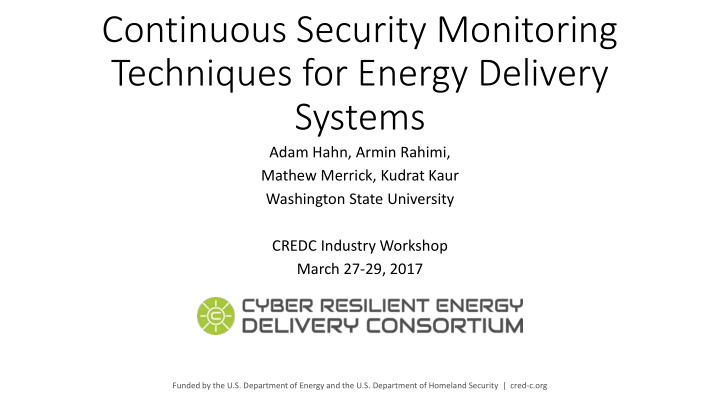



Continuous Security Monitoring Techniques for Energy Delivery Systems Adam Hahn, Armin Rahimi, Mathew Merrick, Kudrat Kaur Washington State University CREDC Industry Workshop March 27-29, 2017 Funded by the U.S. Department of Energy and the U.S. Department of Homeland Security | cred-c.org
Challenge Verify configurations Difficult to assess security System is free from malicious actors Problems Legacy systems/devices don’t support Within EDS Fragility/performance Unclear what data is beneficial Benefits End nodes are boring cred-c.org | 2
Continuous Monitoring Information System Continuous Monitoring (ISCM) : “maintaining ongoing awareness of information security, vulnerabilities, and threats to support organizational risk management decisions” “ Continuous security state monitoring of all energy delivery system architecture levels and across cyber- physical domains is widely adopted by energy sector asset owners and operators” – DOE Roadmap to Achieve Energy Delivery Systems Cybersecurity Year 2020 Goal Sources: Roadmap to Achieve Energy Delivery Systems Cybersecurity. DOE, 2011. NIST 800-137: Information Security Continuous Monitoring (ISCM) for Federal Information Systems and Organizations cred-c.org | 3
EDS Efforts and Tools SCE: Common Cybersecurity Services (CCS) - Edge security client so devices and be Utilities monitored, utilizes Trusted Network Connect (TNC) and PKI NetAPT Analysis and verification of firewall logs CyberLens: Network monitoring and analytics N-Dimension: Network monitoring and analytics Vendors Security Matters: Network monitoring and End-point vuln assessment Tenable: Security center/Network monitoring/event logs/vuln scanning Monitoring of grid devices Tripwire: Federal Special Publication 1800-7A “Situational Awareness For Electric Utilities” Feb 2017 NIST: cred-c.org | 4
Smart City Testbed cred-c.org | 5
Test System Corporate IT network FW HMI Distribution Mgmt System Control Center SCADA Server FW WAN FW Gateway Switch Substation Relays cred-c.org | 6
CM Platform Corporate IT network Platform based on ELK Stack FW (Elasticsearch, Logstash, Kibana) Data HMI Distribution Mgmt System Collection Control Visualization Center Syslogs SCADA Server Dashboards Win Event FW Logs WAN Credential Scans FW Distributed searching and analysis Relay Gateway across all data Switch Configs Netflows Substation Relays Real-time monitoring, alerts, and Snort metrics plugins Analysis cred-c.org | 7
Attack Demo cred-c.org | 8
Observable Events Corporate IT network 1) VPN Connection FW VPN Connection Log 2) Connection to DMS Feb 23 openvpn 18389 TCP connection HMI Distribution Mgmt System established with [AF_INET] Netflow Logs Control Src Addr: 192.168.0.12: 192.168.168.23 Dst Addr: 192.168.2.10 Center SCADA Server FW 3) Malware Installation Snort Logs Src Addr: 192.168.0.12 WAN Dst Addr: 192.168.2.10 Win Event Logs Netflow Logs FW Account was successfully Src Addr: 192.168.0.12 logged on: Logon ID: 0x3E7 Switch Dst Addr: 192.168.2.10 Gateway Substation 4) DNP3 Message Relays Win Event Logs Netflow Logs Network connection Src Addr: 192.168.2.101 Dst Addr: 192.168.2.10 service entered running state cred-c.org | 9
Information Sharing Scenario cred-c.org | 10
Information Sharing Scenario Netflow – VPN session Netflow – DNP3 session Window event log cred-c.org | 11
Monitoring of EDS devices Original Configuration Disable overcurrent protection Relay Conf Tool Distributed searching and Real-time monitoring, alerts, analysis across all data and metrics plugins EDS devices do not provide OS level interfaces • Can utilize configuration interfaces to obtain security data • Utilize standard protocols (FTP/HTTP) • Developed Python/Logstash tools to: • 1. Connect to relays 2. Remotely pull configuration 3. Parse configs and dump to logstash cred-c.org | 12
Number of Observations Assume: Number of events per week: 100 substations one year 3,494,504 events 802 Netflows: Probability of attack given an event 1 attack/year Logs (DMS): 105 P(I|A) = ~0.1% Attack generates 5 events 164 Logs (Sub GW): IDS Snort alerts: 296 Prob attack = 1.4 x 10 -6 # of Anomalies >> # of Attacks True Positive = .999 Total: 1367 Need to identify key events to monitor! False Positive = .001 Reference: The Base-Rate Fallacy and the Difficulty of Intrusion Detection Stefan Axelsson. ACM Transactions on Information and System Security, Vol. 3, No. 3, August 2000, Pages 186–205. cred-c.org | 13
Performance Impacts of Scanning Systems DMS HMI Sub Gw Tools 100% OpenVAS 100% Ovaldi cred-c.org | 14
Continued Efforts 1. Continued analysis of observable events on EDS platforms and devices 2. Evaluation of security assessment tools on EDS platforms 3. Attack simulation and analysis of corresponding data cred-c.org | 15
Thanks ahahn@eecs.wsu.edu https://github.com/wsu-smartcity cred-c.org | 16
http://cred-c.org @credcresearch facebook.com/credcresearch/ Funded by the U.S. Department of Energy and the U.S. Department of Homeland Security
Recommend
More recommend